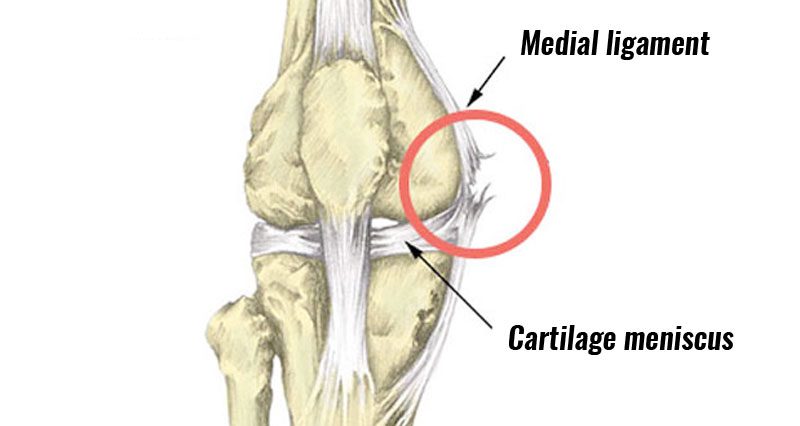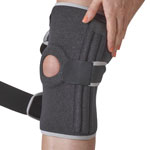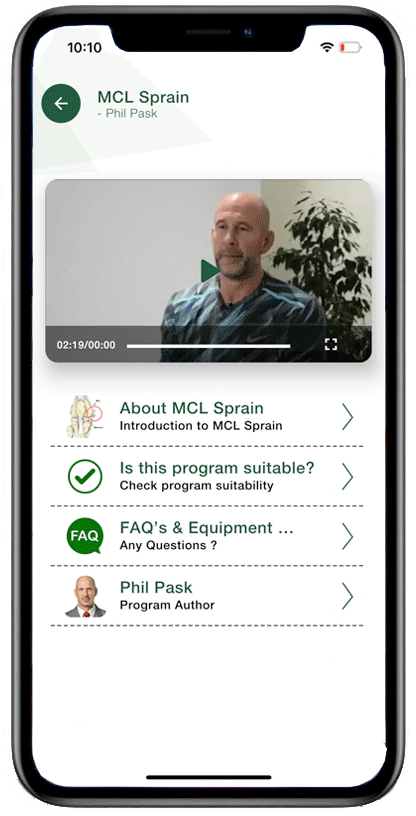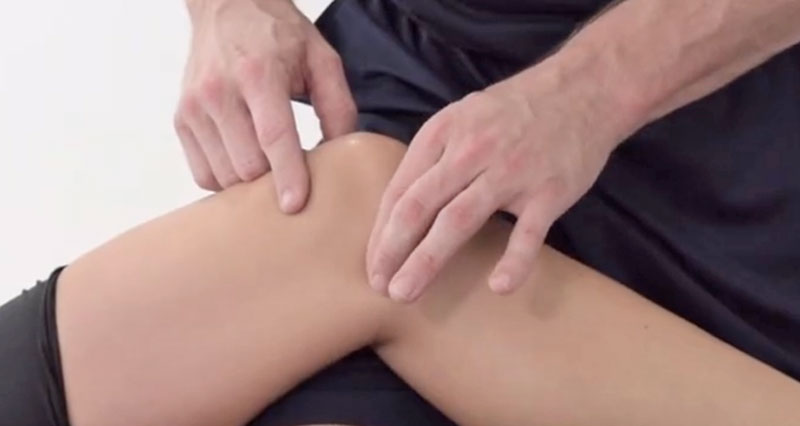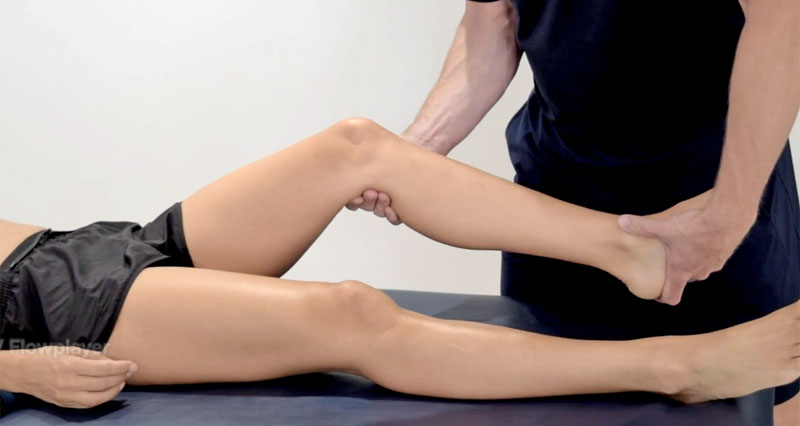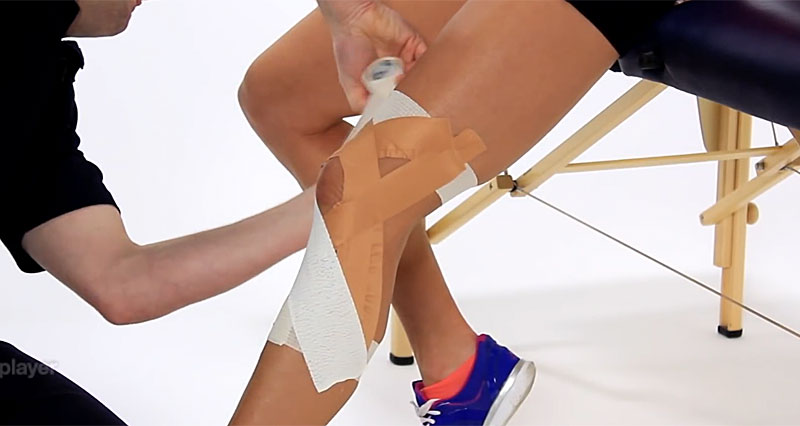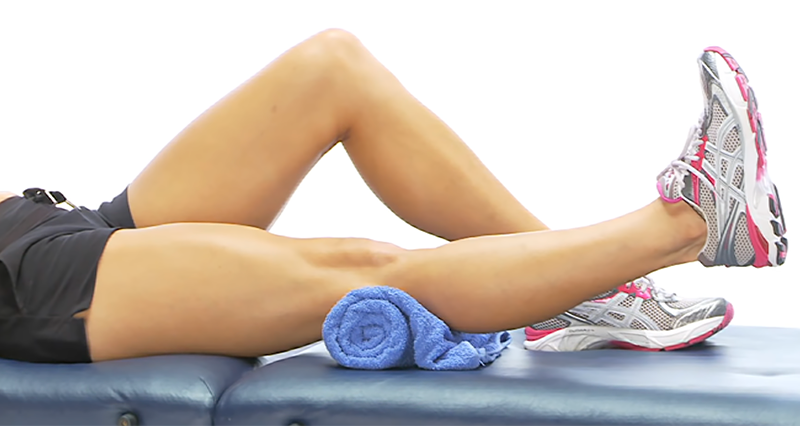An MCL sprain or medial collateral knee ligament sprain is a tear of the ligament on the inside of the knee. It usually occurs suddenly from twisting or direct impact. However, it may develop gradually over time.
Medically reviewed by Dr. Chaminda Goonetilleke, 5th Dec. 2021
Symptoms | Anatomy | Causes | Treatment | MCL rehabilitation program
MCL sprain symptoms
Symptoms of an MCL sprain (Medial knee ligament sprain) depend on the severity of your injury and include:
- Pain and/or tenderness on the inside of your knee.
- You may or may not have swelling depending on how bad your MCL injury is.
- Your knee may feel uncomfortable or weak.
- More severe sprains will be significantly painful with rapid swelling.
- You will have a positive result for the valgus stress test.
MCL sprains are graded 1, 2, or 3 depending on severity.
- More on MCL sprain diagnosis
Anatomy
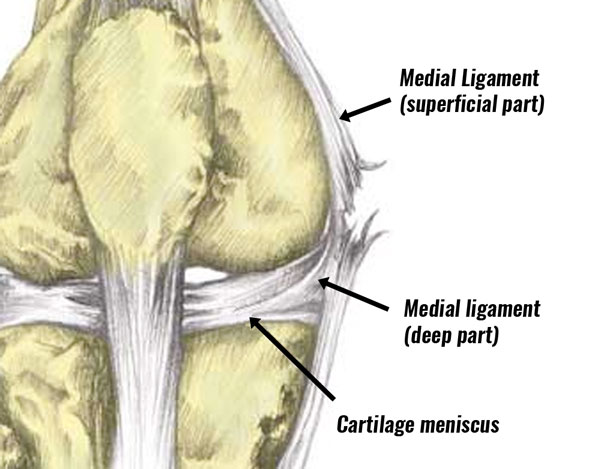
The medial collateral ligament (or MCL for short) connects the thigh bone (femur) to the shin bone (tibia) on the inside of your knee.
It provides stability to your knee, preventing it from moving sideways. In particular from forces applied to the outside of the knee.
The MCL itself has two parts to it:
- A deep section of the ligament attaches to the cartilage and capsule in the knee.
- Also, a superficial band originates in the lower part of the femur and attaches to an area on the upper and inside surfaces of the tibia.
What causes an MCL sprain?
MCL sprains usually occur suddenly as acute knee injuries, however, they can develop gradually over time.
Sudden onset/acute injuries
Medial collateral ligament injuries are common in contact sports such as football, rugby, and martial arts. However, they can also occur in daily activities such as falling and/or twisting action your knee joint.
Direct trauma
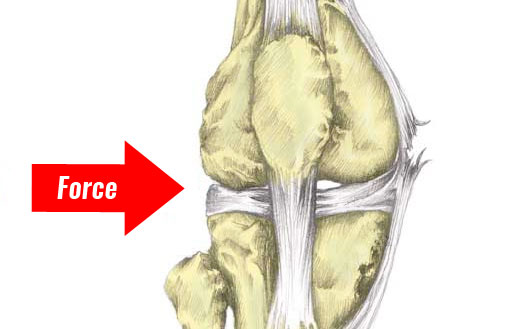
Injury to the MCL often occurs from a direct impact to the outside of your knee. In particular, when your knee is slightly bent. As a result, the medial ligament on the inside of your knee becomes stretched and if the force is great enough, some or even all of the fibres will tear.
The deep part of the ligament is prone to becoming damaged first. This may lead to a medial cartilage meniscus injury.
Twisting
Twisting your knee can also cause a medial ligament sprain, which may also result in an ACL tear.
Attempting to turn quickly, when your foot is firmly planted on the ground will result in a twisted knee. As a result, the inside of the joint opens, tearing the medial ligament.
Gradual onset MCL sprains
Repetitive sideways forces on your knee (known as valgus forces) can gradually, over time lead to an MCL sprain.
For example, repeatedly kicking a football with the inside of your foot. Or kicking in martial arts.
However, gradual onset pain on the inside of your knee should also be considered for pes anserine tendinopathy or bursitis.
Treatment for medial ligament sprains
Treatment for medial ligament sprains consists of immediate first aid followed by a full MCL rehab program.
Cold therapy & compression
Immediate first aid is to apply the PRICE principles (Rest, Ice, Compression, Elevation) as soon as possible. Apply ice or a cold therapy wrap for 10 to 15 minutes and repeat every hour.
You can reduce the frequency as your symptoms improve.
Do not apply ice directly to the skin because it may cause ice burns. Instead, use a wet tea towel or even better, a commercially available cold therapy wrap. These are more convenient to use and will apply compression to your knee as well.
Rest
You should rest from training or any activities which are painful. This is important to allow healing to take place. If you continue to train or do any activity which causes pain, this will only prevent healing and prolong your recovery.
Wear a knee brace
Wear a compression bandage or knee support to help reduce any swelling and protect your joint. This is particularly important in the early stages.
Later, a hinged knee brace is best, particularly for grade 2 and 3 injuries. These have solid metal supports down the sides to prevent sideways movement of the joint.
More severe grade 2 and full grade 3 injuries may require a limited motion-hinged knee brace. These enable you to restrict the amount of bend in your knee joint.
Electrotherapy
A professional therapist may use electrotherapy treatments such as Ultrasound to help control swelling and pain. Ultrasound works by sending high-frequency sound waves into the tissues. This results in a micro-massage effect and helps to reduce swelling.
MCL sprain taping
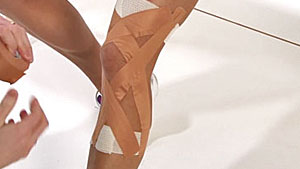
Taping your knee joint can also provide a high level of support and protection. Sports taping is useful in the early stages, as well as later on when you return to full training.
Sports massage
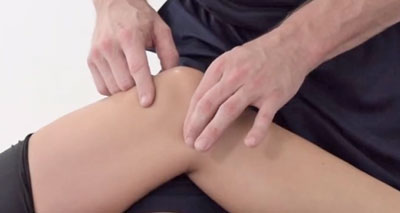
You should avoid massage to the injured ligament in the early, acute stage.
Later, however, as your ligament starts to heel, a light cross friction massage may help. It is particularly useful if you have persistent pain during the later stages of rehabilitation.
Do I need surgery?
Most medial ligament sprains do not require surgical treatment. However, if you have additional damage to the joint such as an ACL tear then you may benefit from having surgery.
However, it is controversial as to whether there is any advantage, even with grade 3 injuries to treating them surgically as opposed to bracing and rehabilitation exercises.
How long will it take to recover?
- A mild MCL injury or grade one sprain should take 3 to 6 weeks to make a full recovery.
- A more severe grade 2 or grade 3 injury may take 8 to 12 weeks.
Rehabilitation & exercises
Our MCL sprain rehabilitation program has been created by International Rugby Physiotherapist Phil Pask and takes you step-by-step from injury to full fitness.
It is criteria based rather than a timeline so you progress at your own pace, regardless of how severe your injury is.
It takes you from initial injury to full competition fitness and tells you exactly what treatment and exercises you need to do each day.
Mobility & stretching
Initially, mobility exercises are done to restore a full, pain-free range of movement. In the early stages, isometric strengthening exercises (static muscle contractions) can be done to help maintain muscle strength and prevent muscle wasting whilst the ligament heals.
Activation exercises
These exercises are aimed at maintaining your hip abductor muscles (outside of the hip). It is important these muscles keep firing and stay in good condition ready for the demands later in the program.
Strengthening
As your ligament heals, strengthening exercises such as mini squats, leg presses, and step-ups can be done. But movements involving a change of direction or sideways stresses should be avoided until much later in the rehabilitation program.
Movement control
These are proprioception-type exercises, aimed at improving your balance, control, and spacial awareness.
Functional exercises
These bridge the gap between basic rehabilitation and sports-specific type drills. They begin with walking drills and progress through skipping-type sprint drills and agility training.
- Go to the MCL rehabilitation program
Expert interview
Elite Football Physiotherapist Neal Reynolds explains MCL sprain treatment
References & research
- Indelicato PA. Isolated medial collateral injuries in the knee. J Am Acad Orthop Surg 1995;3(1):9–14.
